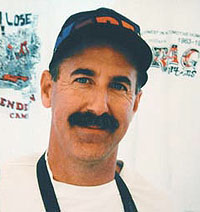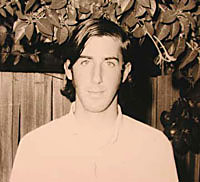|
|
|||||||

|
|
||||||
|
|
|||||||
|
For as long as I could remember, my dad kept stacks of Hot Rod Magazine, Motor Trend and other paper automobilia lying around our house in suburban Long Beach, California, of which I would systematically view for the cool pictures, upon the mailman's deliverance. Like a kid in the proverbial candy store, I would paw through the pages in wide-eyed wonder, and was specifically captivated by the color shots of "rail" dragsters smoking the tires. I mean, what WERE those things doing in creating such an awesome spectacle? My dad, who was once president of the Horseless Carriage Club of America, also kept an array of work-in-progress Model-T, Model-A, Edsel, Ford Retractable, and other "non-racing" concoctions in our back yard through the years, which proved worthless in nurturing my need for speed. Rarely, would he even acknowledge the speeding machines depicted in his magazines, which held the answers to my puzzling questions.
The track, which was a year-round road, was truly unique: approximately 1/8-mile, with single cars flag-started from a standing start. Adding to a competitor's agony was the fact that they would have to traverse the measured distance, on a hill with something like a 35-degree incline, on what was called by locals, "Shell Hill." (Note: at the crest of the road sat Bill Stroppe's race shop, and years later, Mert Littlefield's blower shop would reside just a few doors down.) It was supposed to be a contest of machine-versus-clock, but it was more like a slow-motion sprint enjoyed by men who resembled beef jerky. Likewise, the cars were non-modified, antique "slugs", which labored through the gears. Many would simply move forward, stop, then travel backwards into awaiting bales of hay. Others actually topped the hill with a semblance of forward motion. Everything was going fine, by the "beef jerky", white uniformed officials' standards, that is until a certain machine was heard to fire up in the distance, with a distinctive, pipe-cackling motor response at many whacks of the throttle. Moments later, in a swirl of dust and fumes it emerged, an incredibly cool and nearly bare-framed creation with a flathead motor, a set of Stromberg carbs, and a distinct smell (which I later found out was nitro) from its short, snarling pipes. I can still recall its "pilot", a long, blonde-haired dude, wearing a grease-stained T-shirt, and an equally distinct, German helmet. From the look on the officials' faces, it was apparent that this particular competitor might not have been a legitimate "entry", as evidenced by much arm-waving and denture-spewing vocals by the creamed corn brigade. This apparently fell on deaf ears, as the fearless hot rod's driver paid nary a glance to their restraint attempts, and seemed more amused by his likewise rag-tag biker buddies, who cheered and hollered with every tire-churping, mini burnout. All of this was taking place a scant few yards from my position, at the starting line area, complete with a Brownie camera around my neck.
|
|||||||
|
|
|||||||
|
|
|||||||
|
Copyright 2000, Drag Racing Online and Racing Net Source |
|
||||||


 Looking
back some 31-plus years, it's evident my life as a full-time drag racing
photojournalist got off to a confusing, yet interesting start. That's
because I went to my first drag race twice -- on separate weekends.
No wonder he's confused, you say? Please, let me explain.
Looking
back some 31-plus years, it's evident my life as a full-time drag racing
photojournalist got off to a confusing, yet interesting start. That's
because I went to my first drag race twice -- on separate weekends.
No wonder he's confused, you say? Please, let me explain. That
all changed in 1969, when our family made a trek just a few miles from
our home to Signal Hill. It was about a mile-round, former-oil derrick
lump that rises from nowhere in the heart of Long Beach. The purpose
of our sojourn was the annual Model-T Hill Climb, hosted by the local
Long Beach chapter.
That
all changed in 1969, when our family made a trek just a few miles from
our home to Signal Hill. It was about a mile-round, former-oil derrick
lump that rises from nowhere in the heart of Long Beach. The purpose
of our sojourn was the annual Model-T Hill Climb, hosted by the local
Long Beach chapter.